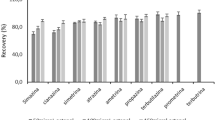Summary
The advantages of liquid chromatography with diode array and mass spectrometric detection are described for the direct characterization of the photodegradation products of Fenitrothion, Atrazine and Diuron in distilled water and artifical seawater samples. The photodegradation (UV λ>290 nm) of the herbicides Atrazine and Diuron was examined in distilled water and in artificial seawater containing humic acids. Major photodegradation products were hydroxyatrazine and Monuron, respectively. The results showed a faster degradation in seawater as compared to distilled water for Atrazine whereas for Diuron a quenching effect was observed thus retarding photodegradation. The photodegradation of Fenitrothion was also investigated. For this pesticide, hydrolysis predominates in seawater and photolysis is very slow in distilled water, so that acetone was needed as photosensitizer.
Similar content being viewed by others
References
“Agricultural chemicals in ground water: proposed pesticide strategy”, US EPA, Washington D.C. (1987) pp 21–27.
C. D. Watts, L. Clark, S. Hennings, K. Moore, C. Parker in “Pesticides: Analytical requirements for compliance with EEC directives”, Water Research Pollution Report 11, Commission of the European Communities, Brussels, Belgium (1989) pp 16–34.
R. Frank, L. Logan, Arch. Environ. Contam. Toxicol.17, 741 (1988).
H. O. Esser, G. Dupuis, E. Ebert, C. Vogel, G. J. Marco, in “Herbicides: Chemistry, degradation and mode of action”, Vol. I,PC. Kearney andD. D. Kaufman eds. M. Dekker, N. York, (1975) Chp. 2.
G. Durand, D. Barceló, J. Chromatogr., (in press).
M. Mansour, E. Feicht, P. Méallier, Toxicol. Environ. Chem.20–21, 139 (1989).
A. Chukwudebe, R. B. March, M. Otham, T. R. Fukuto, J. Agric. Food Chem.37, 539 (1989).
A. M. M. Roof in “The handbook of environmental chemistry”,O. Hutzinger ed., (1982) Springer-Verlag, Berlin, Vol. 2 part B, pp 43–70.
D. Kotzias, W. Klein, F. Korte, Chemosphere,4, 161 (1974).
H. M. Hwang, R. E. Hodson, R. F. Lee in “Photochemistry of environmental aquatic systems”, ACS symposium series, 327, p 27 (1987).
R. G. Zepp, P. F. Schlotzhauer, R. M. Sink, Environ. Sci. Technol.19, 74 (1985).
W. M. Draper, D. G., Crosby, Arch. Environ. Contam. Toxicol.,12, 121 (1983).
K. Fukuda, Y. Inagaki, T. Marumaya, H. I. Kojima, T. Yoshida, Chemosphere,17, 651 (1988).
G. G. Choudry, in “The handbook of environmental chemistry”,O. Hutzinger ed., (1982), Springer-Verlag, Berlin, Vol. 2 part B, pp. 103–128.
T. R. Steinheimer, M. G. Brooks, Intern. J. Environ. Anal. Chem.17, 97 (1984).
D. Barceló, C. Porte, J. Albaigés in “Pesticides: Analytical requirements for compliance with EEC directives”, Water Research Pollution Report 11, Commission of the European Communities. Brussels, Belgium (1989) pp 115–128.
Fenitrothion: the effects of its use on environmental quality and its chemistry, NRCC (1975) pp 83–85.
D. Barceló, Chromatographia25, 928 (1988).
G. Durand, D. Barceló, Toxicol. Environ. Chem.,25, 1 (1989).
D. Barceló, J. Albaigés, J. Chromatogr.,474, 163 (1989).
D. Barceló, Biomed. Environ. Mass Spectrom17, 363 (1988).
D. Kotzias, M. Herrmann, A. Zsolnay, H. Russi, F. Korte, Naturwissenschaften73, 35 (1986).
V. Pacákova, K. Stulik, M. Prihoda, J. Chromatogr.,442, 147 (1988).
A. Farran, J. De Pablo, D. Barceló, J. Chromatogr.,455, 163 (1988).
C. J. Miles, H. Anson Moye, Chromatographia,24, 628 (1987).
A. Alford, Biomed Mass Spectrom5, 259 (1978).
S. Walia, P. Dureja, S. K. Mukerjee, Pestic. Sci.,26, 1 (1989).
D. Barceló, Org. Mass Spectrom,24, 219 (1989).
A. G. Harrison, “Chemical ionization mass spectrometry”, CRC Press, Boca Raton, FL, (1983) pp 33–38.
Author information
Authors and Affiliations
Rights and permissions
About this article
Cite this article
Durand, G., Barceló, D., Albaigés, J. et al. Utilisation of liquid chromatography in aquatic photodegradation studies of pesticides: A comparison between distilled water and seawater. Chromatographia 29, 120–124 (1990). https://doi.org/10.1007/BF02268696
Received:
Accepted:
Issue Date:
DOI: https://doi.org/10.1007/BF02268696




